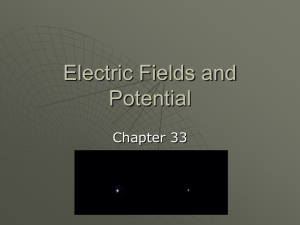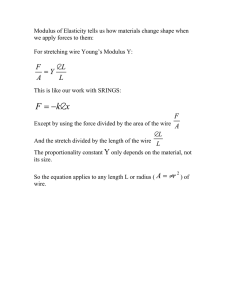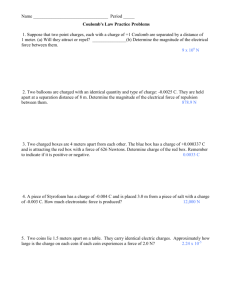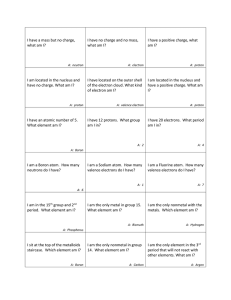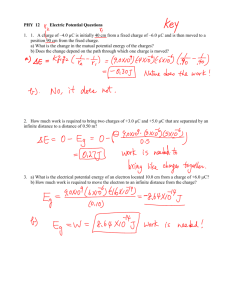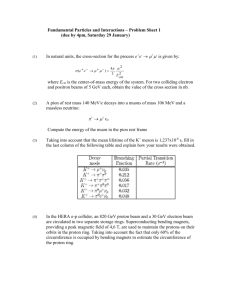77777 F.E. Dunnam PHYSICS DEPARTMENT PHY 2054
advertisement
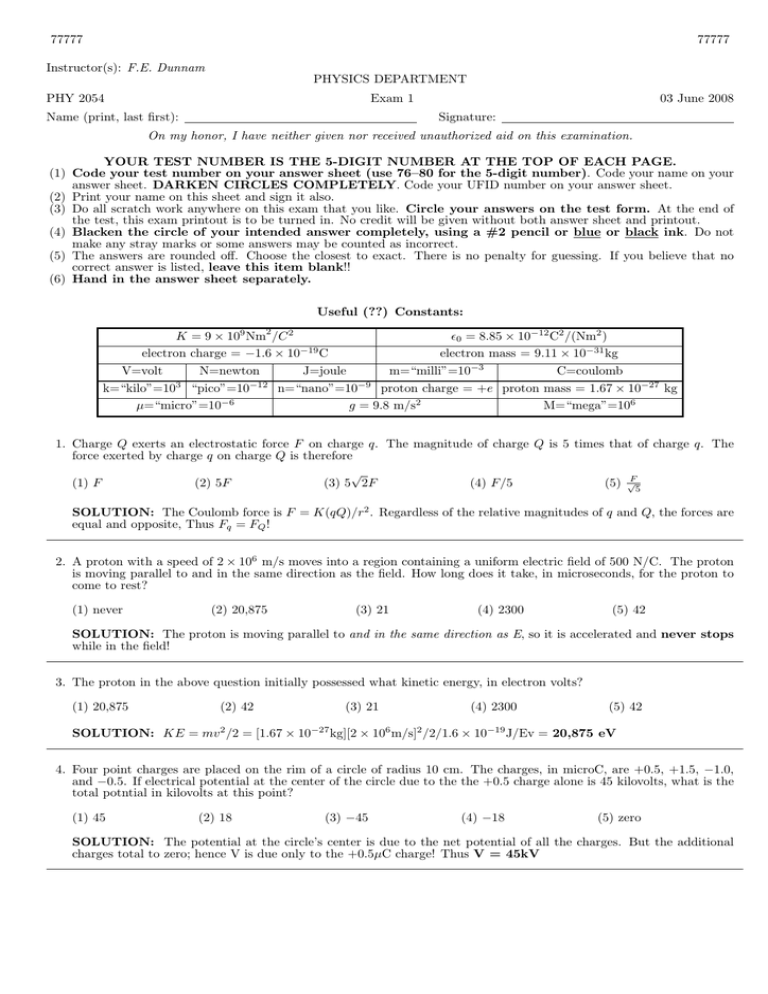
77777 77777 Instructor(s): F.E. Dunnam PHYSICS DEPARTMENT PHY 2054 Exam 1 03 June 2008 Signature: Name (print, last first): On my honor, I have neither given nor received unauthorized aid on this examination. YOUR TEST NUMBER IS THE 5-DIGIT NUMBER AT THE TOP OF EACH PAGE. (1) Code your test number on your answer sheet (use 76–80 for the 5-digit number). Code your name on your answer sheet. DARKEN CIRCLES COMPLETELY. Code your UFID number on your answer sheet. (2) Print your name on this sheet and sign it also. (3) Do all scratch work anywhere on this exam that you like. Circle your answers on the test form. At the end of the test, this exam printout is to be turned in. No credit will be given without both answer sheet and printout. (4) Blacken the circle of your intended answer completely, using a #2 pencil or blue or black ink. Do not make any stray marks or some answers may be counted as incorrect. (5) The answers are rounded off. Choose the closest to exact. There is no penalty for guessing. If you believe that no correct answer is listed, leave this item blank!! (6) Hand in the answer sheet separately. Useful (??) Constants: K = 9 × 109 Nm2 /C 2 ²0 = 8.85 × 10−12 C2 /(Nm2 ) −19 electron charge = −1.6 × 10 C electron mass = 9.11 × 10−31 kg V=volt N=newton J=joule m=“milli”=10−3 C=coulomb 3 −12 −9 k=“kilo”=10 “pico”=10 n=“nano”=10 proton charge = +e proton mass = 1.67 × 10−27 kg −6 µ=“micro”=10 g = 9.8 m/s2 M=“mega”=106 1. Charge Q exerts an electrostatic force F on charge q. The magnitude of charge Q is 5 times that of charge q. The force exerted by charge q on charge Q is therefore √ (1) F (2) 5F (3) 5 2F (4) F/5 (5) √F5 SOLUTION: The Coulomb force is F = K(qQ)/r2 . Regardless of the relative magnitudes of q and Q, the forces are equal and opposite, Thus Fq = FQ ! 2. A proton with a speed of 2 × 106 m/s moves into a region containing a uniform electric field of 500 N/C. The proton is moving parallel to and in the same direction as the field. How long does it take, in microseconds, for the proton to come to rest? (1) never (2) 20,875 (3) 21 (4) 2300 (5) 42 SOLUTION: The proton is moving parallel to and in the same direction as E, so it is accelerated and never stops while in the field! 3. The proton in the above question initially possessed what kinetic energy, in electron volts? (1) 20,875 (2) 42 (3) 21 (4) 2300 (5) 42 SOLUTION: KE = mv 2 /2 = [1.67 × 10−27 kg][2 × 106 m/s]2 /2/1.6 × 10−19 J/Ev = 20,875 eV 4. Four point charges are placed on the rim of a circle of radius 10 cm. The charges, in microC, are +0.5, +1.5, −1.0, and −0.5. If electrical potential at the center of the circle due to the the +0.5 charge alone is 45 kilovolts, what is the total potntial in kilovolts at this point? (1) 45 (2) 18 (3) −45 (4) −18 (5) zero SOLUTION: The potential at the circle’s center is due to the net potential of all the charges. But the additional charges total to zero; hence V is due only to the +0.5µC charge! Thus V = 45kV 77777 77777 5. What is the electrostatic potential energy in Joules of a two-charge system consisting of a 3.4 microC charge and a 6.6 microC charge, 30 cm apart? (1) 0.67 (2) 0.34 (3) −0.34 (4) −0.75 (5) 3.2 SOLUTION: PE = work required to move one charge from ‘infinity’ up to the other charge. W = qV. V for the smaller charge = kq1 /r so PE = (kq1 /r) × q2 = 9 × 109 N m2 /C2 × (3.4 × 10−6 C) (6.6 × 10−6 C)/0.3m = 0.67 J 6. 1.0 microF and 0.5 microF capacitors are connected in series and then connected across a 100V battery. The energy stored in the 1 microF capacitor, in milliJ is (1) 0.56 (2) 0.065 (3) 0.8 (4) 4.3 (5) 15 SOLUTION: The equivalent C is 1/(1/1µF + 1/0.5µF) = 2/3µF The charge on each is Q = C ∆V = 2/3µF × 100V = 67µC U = Q2 /2C = (67µC)2 /1µF = 560µJ = 0.56 mJ 7. A parallel-plate capacitor of capacitance C has charge Q placed on it, at potential V. If the plates are carefully moved twice as far apart, (1) (2) (3) (4) (5) the potential becomes 2V the potential becomes V/2 the charge becomes 2Q the charge becomes Q/2 th capacitance becomes 2C SOLUTION: Charge is always conserved, hence only C and V may change. Doubling the plate separation changes C to C/2. Since Q = C∆V, the new ∆V= 2V 8. The capacitor in the above question [same initial conditions] has a slab of dielectric (κ = 2) carefully inserted between the plates without touching them. Now (1) (2) (3) (4) (5) the the the the the potential becomes V/2 potential becomes 2V charge becomes 2Q charge becomes Q/2 capacitance becomes C/2 SOLUTION: Introducing the dielectric changes C to 2C. But Q is unchanged, so now ∆V = V/2 9. A resistor of resistance R is connected to a battery (voltage V) and dissipates power P . Replacing the resistor with one of resistance 2R will result in what power dissipated? (1) P/2 (2) 2P (3) P/4 (4) 4P (5) none of these SOLUTION: Power P = I∆V = ∆V 2 /R . If R0 = 2R, then P 0 = ∆V 2 /2R = P/2 10. An electric car runs off a bank of 12-V batteries with total stored energy of 30 megaJ at maximum charge. If the motor draws 6 kW when propelling the car at a steady 10 m/s, how far can the car travel, in km? (1) 50 (2) 25 (3) 100 (4) 150 (5) 75 SOLUTION: Power P = U/t, so t = U/P . v = x/t ≥ x = vt = vU/P = (10m/s)(30 × 106 J)/6 × 103 J/s ≥ x = 50 × 103 m = 50 km 11. A standard incandescent light bulb is labeled “100 W, 120V”. Its resistance in ohms while burning, and its approximate resistance when ‘cold’ are likely to be, respectively, (1) 144, less (2) 144, greater (3) 240, less (4) 120, greater (5) 12, less SOLUTION: P = ∆V 2 /R so R = ∆V 2 /P = 120V/100W = 144Ω. The ‘cold’ resistance is obviously less! 77777 77777 12. A ping pong ball covered with a conducting graphite coating has a mass of 5 × 10−3 kg and a charge of −4µC. What electric field will exactly balance the weight of the ball? (1) 1.2 × 104 N/C downward (2) 8.2 × 102 N/C upward (3) 2.0 × 10−7 N/C downward (4) 5.1 × 106 N/C upward (5) 1.2 × 104 N/C upward 2 SOLUTION: For balance in the E-field, qE = mg ≥ E = mg/q = [5 × 10−3 kg × 9.8m/s ]/4 × 10−6 C = 1.2 × 104 N/C, down. [E must be downward for force on a − charge to be upward!] 13. A charge of +3 C is at the origin. When charge Q is placed at 2 m along the positive x-axis, the electrostatic force on a charge +q placed at 2 m along the negative x-axis (point x) becomes zero. What is the value of Q? (1) −12 C (2) −6 C (3) +9 C (4) −3 C (5) +12 C SOLUTION: For the Coulomb forces to balance on a charge q at X, KqQ/(4m)2 − Kq(3C)/(2m)2 = 0 ≥ Q = 3C[−16/4] = –12C. 14. Electrons in a particle beam each have a kinetic energy of 3.2 × 10−17 J. What is the magnitude of the electric field that will stop these electrons in a distance of 0.1 m? (1) 2000 N/C (2) 1000 N/C (3) 200 N/C (4) 4000 N/C (5) 3200 N/C SOLUTION: work done by E = F x = KE ≥ qEx = KE ≥ E = KE/ex So E = 3.2×10−17 J/(1.6×10−19 C×0.1m) = 2000N/C 15. An electron moves on a path perpendicular to the direction of a uniform electric field of strength 3.0 N/C. How much work is done on the electron as it moves 15 cm? (1) zero (2) 4.8 × 10−20 J (3) −4.8 × 10−20 J (4) 1.6 × 10−20 J (5) −1.6 × 10−20 J SOLUTION: Charged particles, moving perpendicular to E-field lines must therefore be moving along equipotential lines, so the work done is zero. 16. If C1 = 15µF, C2 = 10µF, C3 = 20µF, and Vo = 18 V, determine the energy stored by C2 . (1) 0.18 mJ (2) 0.32 mJ (3) 0.50 mJ (4) 0.72 mJ (5) none of these SOLUTION: C1 is in series with the parallel combination of C2 and C3 . Thus Ceq = 1/[1/15 + 1/(20 + 10)] = 10µF. Then the charge on C23 = 10µF × 18V = 180µC. The potential difference ∆V across C23 = 180µC/30µF = 6V , so the energy stored in C2 = 21 CV 2 = 1/2(10µF )(6V )2 = 0.18 mJ 17. Replacing a wire of resistance R with another of the same material and length but with three times the diameter will have the effect of changing the resistance to: (1) R/9 (2) 0.33R (3) 3.0R (4) 9.0R (5) R/3 SOLUTION: Since R = ρl/A , and A = πr2 , tripling the wire’s diameter results in A0 = π(3r)2 = 9πr2 = 9A. So R0 = R/9. 77777 77777 18. When an electric current exists within a segment of conducting wire that obeys Ohm’s law, the electron drift velocity is proportional to: (1) (2) (3) (4) (5) the electric field between the ends of the segment. the length of the segment. the electron’s mass. the wire’s cross-sectional area. none of these. SOLUTION: Across the wire segment of length x, the electric field E = ∆V /x . The current I = nqvd A ≥ vd = I/nqA. But by Ohm’s Law, I = ∆V /R . Also, R = ρx/A . Thus vd = (∆V /R)/nqA = ∆V /(ρx/A)/nqA = ∆V /x) = E/ρnq. 19. A metal wire has a resistance of 25.00Ω under room temperature conditions of 25◦ C. When the wire is heated to 85◦ C the resistance increases by 0.75Ω. What is the temperature coefficient of resistivity of this metal? (1) 5.0 × 10−4 /C (2) 1.27 × 10−3 /C (3) 1.5 × 10−3 /C (4) 2.5 × 10−3 /C (5) 3.6 × 10−3 /C SOLUTION: R = R0 (1 + α∆T ) = R0 + R0 α∆T ) ≥ α = (R − R0 )/R0 ∆T = 0.75/[(25 × 103 )(85 − 25) = 5 × 10−5 /C 20. A high-voltage transmission line carries 1000 A at 700 kV for a distance of 100 miles. If the resistance in the wire is 0.1Ω/mile, what is the power loss due to ohmic heating of the line? (1) 10 MW (2) 100 kW (3) 10 kW (4) 100 MW (5) none of these SOLUTION: R = 0.1Ω/mi × 100mi = 10Ω. Ohmic (heat) loss in line = I 2 R = (1000A)2 × 10 = 107 W = 10 MW
